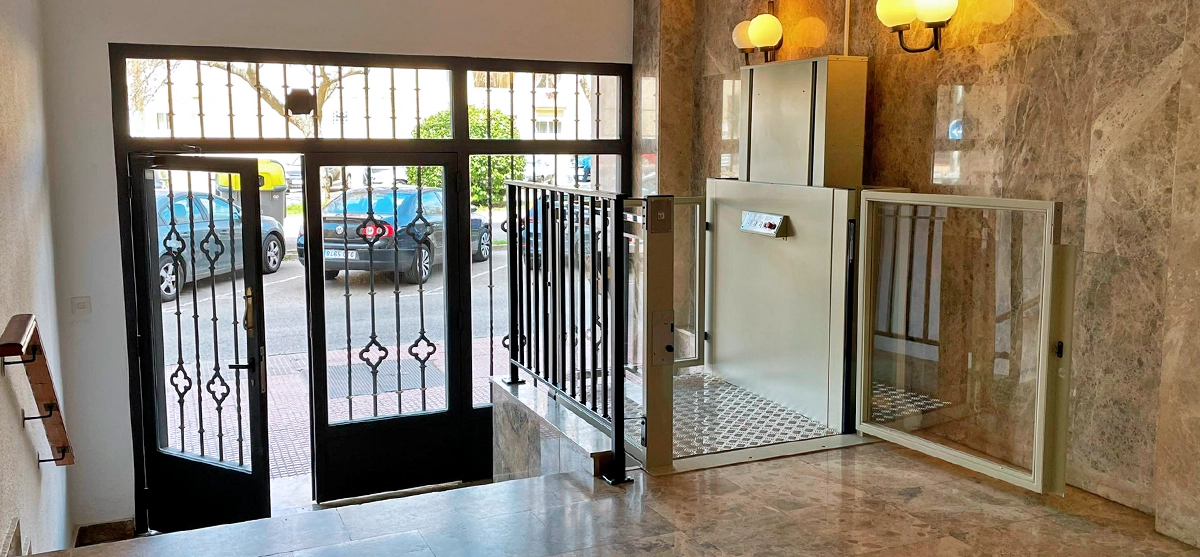One of the questions that appears frequently among the communities of neighbors and homeowners has to do with elevators and the need to lower them to zero level. Doubts are often linked to the requirements to do so and when it is mandatory.
So, below, we will answer this and much more.

What does it mean to lower a lift to zero level?
To begin with, when we talk about lowering the elevator to zero level, we are referring to the elimination of any step or architectural barrier in general that may exist to access the interior of the elevator. This, understanding that steps can represent a great inconvenience for people with reduced mobility.
In this sense, lowering the elevator to zero elevation means to improving accessibility of the community. This is an aspect that should be focused on, especially in countries such as Spain where there are a large number of old buildings, which still do not have these accessibility measures, among others.
In order to ensure full accessibility to housing for people with reduced mobility or over 70 years of age, since June 2013, there is a law that establishes the obligation to condition all buildings. In addition, in the article 10.1.b of the Horizontal Property Law 49/1960 it is determined that, in the case of buildings with persons belonging to the aforementioned categories, the following shall be mandatory install an elevator or lower it to zero, as appropriate without the need for prior agreement by the board of owners, because it is considered an improvement in the quality of life for everyone.

Is it mandatory to go down to zero elevation?
Based on the above, it is mandatory to lower the elevator to zero level if it is the only way to guarantee accessibility in a building. This means that in cases where there is, for example, a ramp, this is no longer mandatory and must have a prior agreement by the owners’ meeting.
Another factor that affects the obligatory nature of the operation has to do with the cost of the operation. The work must be carried out compulsorily if the cost does not exceed 12 ordinary monthly payments of common expenses, once public aid or subsidies have been deducted.
It should be noted, as mentioned above, that the situation changes in cases where the request to lower the elevator to zero level is made to the community or the communal president by a person with reduced mobility or a person over 70 years of age. When this happens, article 10.1 is immediately applied, which establishes that it will be mandatory to lower the elevator to zero level and will not require prior agreement by the owners’ or community meeting.
How is the drop to zero level paid for?
Now that we have seen what it consists of and in which cases it is mandatory to lower the elevator to zero level, we want to tell you how the payment of the process is defined. Generally, the expenses involved are divided among all the owners of the community, according to their participation quota for common areas, established in the Horizontal Property Law.
In cases where the building has commercial premises, the community may elect to exempt the owners of the premises from payment.
With regard to the total cost of the work, once the subsidies and public aid that may be obtained have been deducted, if the annual cost is no more than 12 ordinary monthly installments, the expense must be assumed by all the neighbors. However, if the installment is higher than these 12 monthly payments, owners interested in lowering to zero are given the option of assuming the excess amount.

Is it necessary to change the lift?
Another question that frequently comes up in connection with this issue is whether it is necessary to change the elevator in order to lower it to zero elevation. The answer is that, in principle, this would not be necessary. In any case, there are three situations in which owners may decide to change the elevator to comply with this requirement:
- One of them is when you are looking to modernize the elevator, taking advantage of the work to change the device.
- Optimize the shaft dimensions, installing a new elevator with a larger useful car surface and/or a larger free passage of doors.
- Another is when there is a lack of space for the current elevator pit, because more modern models usually take up less space to achieve this purpose.
What other accessibility alternatives exist?
Finally, we have previously mentioned that lowering the elevator to zero level is not mandatory in cases where there are other accessibility alternatives. As we have mentioned, what is mandatory, in reality, is to eliminate architectural barriers in buildings. However, if other alternatives are available, it will not be necessary to go to the zero elevation.
In this sense, in addition to traditional ramps, what many neighborhood communities choose is to incorporate a vertical platform. These can be solutions for when you do not want to carry out the work of lowering to zero level. In any case, it is still the most effective way to comply with current regulations and guarantee a good quality of life for all the inhabitants of the condominium.
At Aszende we offer a comprehensive range of solutions to cover all vertical mobility needs, including elevator installation and upgrades. In addition, we have technicians who travel to the facilities to offer personalized alternatives tailored to the needs of each case. Contact us and find out how we can help you.
José Ignacio Alcaraz
Aszende Facilities Director
We can help you
Would you like to know more about our products, services and vertical mobility solutions?
Do not hesitate and contact us without any obligation using this form and we will contact you as soon as possible.
If you want to know more about the treatment of your data, please visit our privacy policy.
